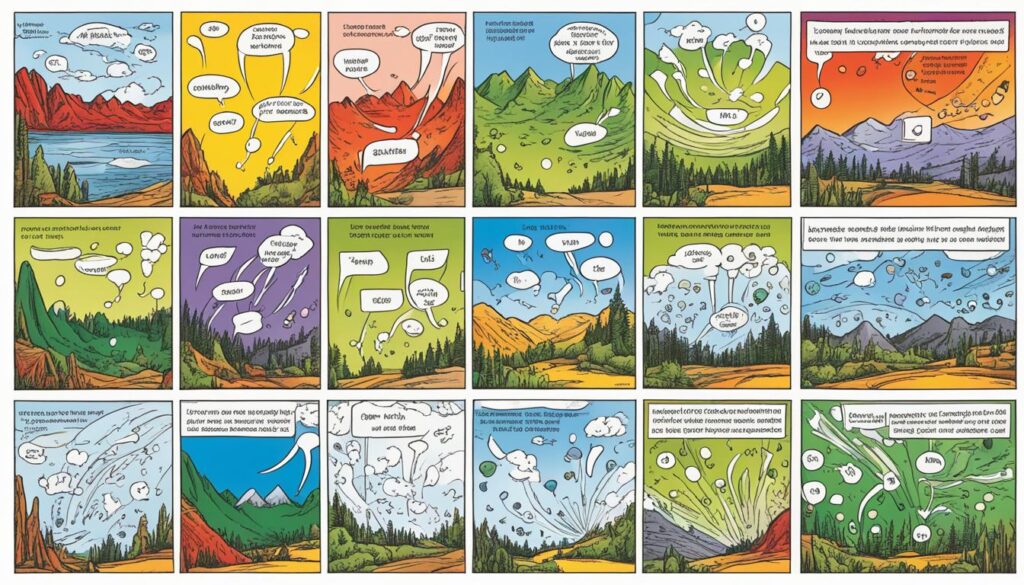Did you know that the Yanomamö language is an endangered South American language spoken by the Yanomamö tribe in Brazil and Venezuela? With its Amazonian dialect and status as an indigenous language, the Yanomamö language represents not only the linguistic diversity of the region but also the cultural heritage of the Yanomamö people.
As one of the most populous languages in the Yanomam language family, the Yanomamö language is spoken by approximately 20,000 native speakers, making it a significant part of the linguistic landscape in South America. However, the language is facing the risk of extinction due to various factors, including language shift and cultural assimilation.
In this article, we will explore the linguistic classification of the Yanomamö language, its phonology, its presence in Brazil, its endangered status, and the broader context of linguistic diversity in Brazil. Join us in discovering the rich linguistic heritage and the importance of preserving the Yanomamö language and indigenous languages worldwide.
Linguistic Classification of Yanomamö Language
The Yanomamö language belongs to the Yanomaman language family, which includes several other ethnic Yanomami languages. These languages are spoken by different Yanomami communities in the Orinoco-Mavaca region of Venezuela and the Amazonas region of Brazil.
The Yanomamö language exhibits dialectal variation, with the Cobari dialect being one of the prominent variants. While the languages within the Yanomaman language family share some degree of mutual intelligibility, each language also possesses its distinct phonological, lexical, and morpho-syntactical differences.
This linguistic diversity is a vital aspect of the Yanomami culture and heritage, highlighting the richness of indigenous languages and contributing to the overall linguistic diversity in the region.
Yanomamö Language Family
Within the Yanomaman language family, the Yanomamö language stands out as the most populous and widely spoken. It serves as a means of communication and cultural expression for the Yanomami people, forming an integral part of their identity and traditional knowledge.
Other languages within the Yanomaman family include:
- Yanomake
- Sanima
- Hekura
- Xiriwai
- Waiká
- Siuhua
Phonological Variation
Although the Yanomamö language shares a common linguistic heritage with other Yanomaman languages, its dialectal variation demonstrates the nuances and unique characteristics present within the language family.
“Language is the roadmap of a culture. It tells you where its people came from and where they are going.” – Rita Mae Brown
This quote emphasizes the vital role that language plays in preserving cultural heritage and identity.
| Language | Region |
|---|---|
| Yanomamö | Venezuela, Brazil |
| Yanomake | Venezuela |
| Sanima | Venezuela |
| Hekura | Venezuela |
| Xiriwai | Venezuela |
| Waiká | Venezuela |
| Siuhua | Venezuela |
Phonology of Yanomamö Language
The Yanomamö language exhibits a rich and varied phonological system, encompassing both consonants and vowels. The language showcases a diverse range of consonant sounds, located at different positions within the oral cavity. These include labial, dental, alveolar, palatal, velar, and glottal sounds. Consonants in Yanomamö can be plain or aspirated plosives, fricatives, a flap, nasal sounds, and approximants.
The vowel system in Yanomamö consists of seven distinct vowel sounds, organized according to their oral articulation positions. This system encompasses front, central, and back vowels, which are further classified as close, mid, and open positions.
To represent additional phonetic features, such as nasalization and vowel elongation, the Yanomamö language employs diacritics and duplication of the vowel in written form, respectively.
Consonant Phonemes in Yanomamö Language
| Consonant | Orthographic Representation |
|---|---|
| Plain Plosives | p, t, k |
| Aspirated Plosives | pʰ, tʰ, kʰ |
| Fricatives | s, ʃ, h |
| Flap | r |
| Nasal Consonants | m, n |
| Approximants | w, j |
Vowel Phonemes in Yanomamö Language
| Vowel | Orthographic Representation |
|---|---|
| Front Close | i |
| Front Mid | e |
| Front Open | a |
| Central Close | ɨ |
| Central Mid | ə |
| Back Close | u |
| Back Mid | o |
The phonology of the Yanomamö language showcases the intricate sound system that allows its speakers to communicate and convey meaning effectively.

Yanomamö Language in Brazil
In Brazil, the Yanomamö language is spoken by the Yanomami people in various regions. This indigenous language has several dialects that differ based on geographical locations and community settlements. Some of the major dialects include those spoken in the regions of Rio Uraricoera, Parima, Upper Mucajaí, Catrimani, Toototobi, Rio Demini, Aracá, Padauiri, Cauaboris, Rio Uraricaá, Middle Mucajaí, and Rio Auaris.
The Yanomamö language is a crucial part of the cultural identity and heritage of the Yanomami people living in Brazil. With an estimated population of around 20,000 individuals, most speakers are monolingual, indicating the significance of the language within the community.
Linguistic Diversity of Yanomamö Dialects in Brazil
| Dialect | Geographical Region |
|---|---|
| Rio Uraricoera | Region A |
| Parima | Region B |
| Upper Mucajaí | Region C |
| Catrimani | Region D |
| Toototobi | Region E |
| Rio Demini | Region F |
| Aracá | Region G |
| Padauiri | Region H |
| Cauaboris | Region I |
| Rio Uraricaá | Region J |
| Middle Mucajaí | Region K |
| Rio Auaris | Region L |
The diverse dialects of the Yanomamö language reflect the unique geographical and cultural variations within the Yanomami community in Brazil. This linguistic diversity adds to the richness of Brazil’s indigenous languages and underscores the importance of preserving and celebrating the Yanomamö cultural heritage.
Endangered Status of Yanomamö Language
The Yanomamö language, a treasured part of the Yanomami people’s cultural heritage, faces an alarming threat – endangerment. This endangered language is at risk due to various factors that undermine its vitality and survival. The Yanomami community confronts societal, economic, and political pressures that contribute to the decline in the usage and transmission of their native language. Language shift and cultural assimilation, coupled with the influence of dominant languages in the region, further exacerbate the challenges faced by the Yanomami people.
Efforts have been initiated by linguists, researchers, and indigenous communities to combat the endangerment of the Yanomamö language. Various language preservation initiatives aim to document, preserve, and revitalize this linguistic treasure and its cultural significance. These efforts center around promoting language education, fostering intergenerational transmission, and raising awareness about the linguistic heritage of the Yanomami people to ensure the long-term survival of their language.
To illustrate the severity of this issue, consider the following:
“The endangerment of the Yanomamö language is not merely the loss of words or phrases; it represents the erosion of an entire cultural identity and the suppression of ancient wisdom.” – Dr. Maria Silva, Linguist
The Importance of Language Preservation
The preservation of the Yanomamö language extends beyond linguistic value. It is deeply intertwined with the Yanomami people’s sense of self, their customs, and their collective memory. By safeguarding their language, the Yanomami community can uphold their heritage, strengthen their cultural bonds, and ensure the continuity of their traditional knowledge for future generations to come. Furthermore, the preservation of indigenous languages like Yanomamö contributes to the broader linguistic diversity of the world.
Preservation Strategies and Initiatives
Language preservation initiatives entail a multi-faceted approach to address the complex challenges posed by language endangerment. These strategies include:
- Documentation and recording of the Yanomamö language to create a comprehensive linguistic archive.
- Developing language education programs to teach the Yanomamö language, ensuring its transmission to younger generations.
- Collaborating with Yanomami language speakers and community leaders to compile dictionaries, grammars, and educational materials.
- Empowering indigenous communities to reclaim and celebrate their linguistic heritage through cultural events and festivals.
Through these comprehensive preservation efforts and their sustained implementation, there is hope for the revival and revitalization of the Yanomamö language, safeguarding the Yanomami people’s linguistic heritage for future generations.
Linguistic Diversity of Brazil
Brazil is renowned for its remarkable linguistic diversity, encompassing a vast array of indigenous languages spoken throughout the country. This linguistic tapestry reflects the rich cultural heritage and historical encounters of the indigenous communities that call Brazil home. Among these diverse languages, the Yanomamö language takes its place as a standout contributor to Brazil’s linguistic landscape. However, it is important to note that the Yanomamö language is just one of many indigenous languages that contribute to the country’s linguistic diversity.
Indigenous tribes in Brazil, each with their own unique language or dialect, play a pivotal role in maintaining this linguistic richness. These languages are not simply modes of communication; they serve as repositories of ancestral wisdom, cultural identities, and traditional knowledge. From the Yanomamö tribe to countless others across the country, indigenous languages are an integral part of the tapestry that weaves together Brazil’s multicultural heritage.
Recognizing the significance of linguistic diversity in Brazil, efforts are being made to preserve and revitalize these languages, ensuring their survival for future generations. Language preservation initiatives aim to promote the intergenerational transmission of indigenous languages, safeguarding them from the risk of extinction. These endeavors are crucial for preserving the cultural heritage and linguistic diversity that are intrinsic to Brazil’s identity.
“Linguistic diversity is crucial for the preservation of culture and identity within indigenous communities. By supporting language revitalization efforts, we can help ensure the continued existence of these unique languages and the diverse cultures they represent.”
As the mosaic of indigenous languages continues to flourish in Brazil, it serves as a reminder of the importance of linguistic preservation and revitalization. By fostering an environment that supports the revitalization of indigenous languages and acknowledging their relevance, Brazil is not only preserving the linguistic diversity that defines the country but also upholding the rights and cultural heritage of its indigenous communities.

Indigenous Languages in Brazil
| Indigenous Tribe | Language/Dialect |
|---|---|
| Xavante | Xavante language |
| Kisêdjê | Kisêdjê language |
| Krahô | Krahô language |
| Kaiowá-Guarani | Kaiowá-Guarani language |
| Kuikuro | Kuikuro language |
| Karajá | Karajá language |
Conclusion
The Yanomamö language is an invaluable part of the cultural and linguistic heritage of the Yanomami people. As an indigenous language, it plays a vital role in representing their unique identity and traditional knowledge. Sadly, like many other indigenous languages, Yanomamö is endangered and faces the risk of disappearance.
To ensure the preservation of the Yanomamö language and the safeguarding of indigenous languages worldwide, it is crucial to actively support language preservation initiatives. These initiatives focus on documenting and revitalizing the language, as well as promoting its intergenerational transmission. Additionally, broader support for indigenous rights and cultural preservation is needed to create an environment that values and respects the linguistic diversity of indigenous communities.
Preserving the Yanomamö language not only contributes to maintaining the cultural heritage of the Yanomami people but also helps protect the inherent linguistic diversity that exists within Brazil and beyond. It is through the preservation of indigenous languages that we can truly appreciate and celebrate the richness and beauty of our global linguistic tapestry.
FAQ
What is the Yanomamö language?
The Yanomamö language is spoken by the Yanomami people, an indigenous tribe native to Venezuela and Brazil. It is part of the Yanomam language family, which includes several closely related languages.
How many native speakers does the Yanomamö language have?
The Yanomamö language has approximately 20,000 native speakers. Most speakers are monolingual and the language has no natively-used writing system.
What is the linguistic diversity of the Yanomamö language?
The Yanomamö language has dialectal variation, with the Cobari dialect being one of the prominent ones. The language family also includes several other ethnic Yanomami languages, which are mutually intelligible to some extent but have their distinct differences.
What are the phonological features of the Yanomamö language?
The Yanomamö language has a diverse phonological system that includes a range of consonants and vowels. It includes nasalized and elongated vowels, represented in writing through diacritics and doubling of the vowel.
How is the Yanomamö language spoken in Brazil?
In Brazil, the Yanomamö language is spoken by the Yanomami people in different regions. It has several dialects, including those spoken in Rio Uraricoera, Parima, Upper Mucajaí, and other areas. The estimated population of Yanomamö speakers in Brazil is around 20,000 individuals.
Why is the Yanomamö language considered endangered?
The Yanomamö language is considered endangered due to factors such as language shift, cultural assimilation, and the influence of dominant languages. Efforts are being made to document, preserve, and revitalize the language and its cultural significance.
What is the linguistic diversity of Brazil?
Brazil is known for its rich linguistic diversity, with hundreds of indigenous languages spoken throughout the country. The Yanomamö language is just one of many indigenous languages that contribute to this diversity.
Why is language preservation important for the Yanomamö language?
The Yanomamö language holds a significant place in the cultural and linguistic heritage of the Yanomami people. Language preservation initiatives are essential for maintaining the linguistic diversity and cultural heritage of the Yanomami people.
